If you are looking for a time management technique instead of getting started with that task you’ve been avoiding, you’ve come to the right place.
This article will:
- Introduce you to the basics of the famous Pomodoro technique,
- Help you combat procrastination by sharing some tools and tips for using Pomodoro, and
- Shed some light on the advantages and disadvantages of introducing this popular technique to your routine.
Hopefully, by the end of this article, you will start your Pomodoro tracker, and dive right into that task you’ve been procrastinating on today (instead of tomorrow).
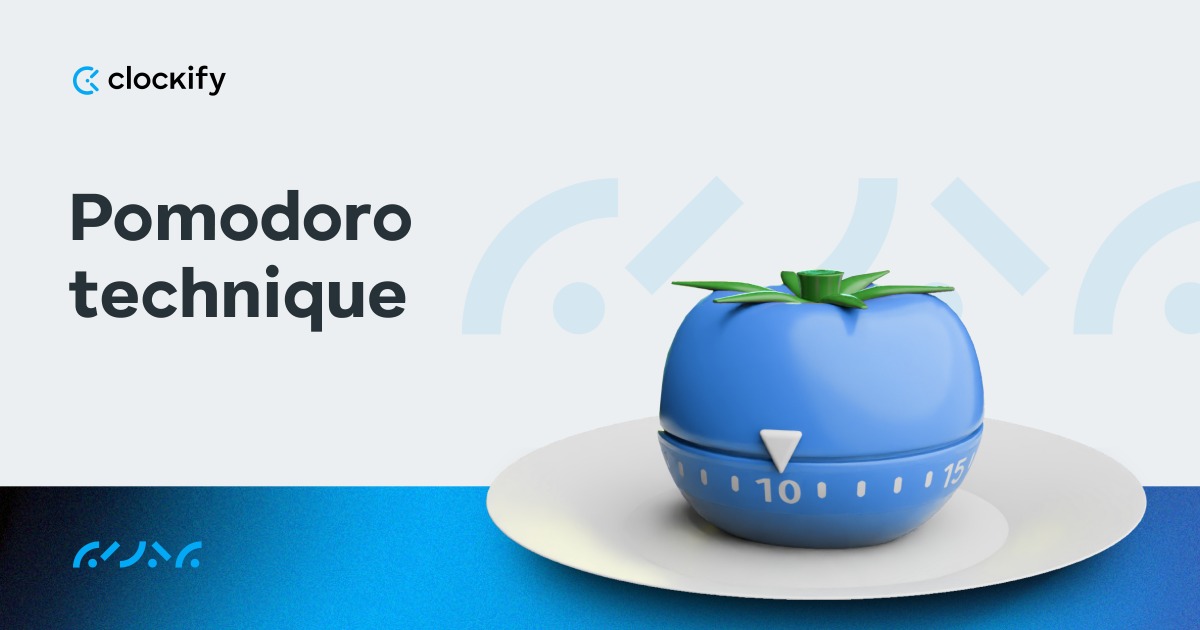
Table of Contents
What is the Pomodoro technique?
The Pomodoro technique is a time management system that improves productivity by helping you focus on your work and get rid of the distractions.
The method was coined by Francesco Cirillo, who had a rough start during his first year at the university in the 1980s.
To increase his focus and block out distractions while studying, Cirillo used a tomato-shaped kitchen timer. He set up his pomodoro (what we call tomato in English) for 10 minutes, placed his focus on the study material only, and voilà — his studying process suddenly improved!
Since Francesco didn’t stop at 10 minutes, but gradually increased his focused time, today, Pomodoro involves using a timer to break down work into 25 minutes intervals, separated by short breaks.
These time intervals are labeled as “work sessions” or pomodoros, and the time between them is labeled as “break time”. Most practitioners spend 25 minutes working and 5 minutes on a break. The work sessions and breaks rotate regularly, and after some time, you take a longer break.
How does Pomodoro work?
Although completing your tasks with a little help of the Pomodoro technique is quite simple, we’ve listed all the steps you should take to make sure you make the most out of it.
- Start a 25-minute timer on your phone or time tracking app.
- Completely focus on your work for the next 25 minutes.
- Stop once the alarm goes off.
- Take a 5-minute break.
- Resume working for another 25 minutes and taking a break for another 5 minutes.
- After 4 cycles, take a 20-minute break.
- Repeat the process until you have finished the project or your workday.
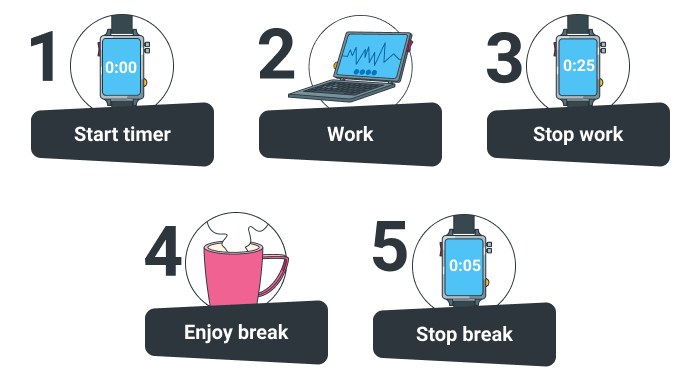
Useful Pomodoro tools and apps
There are several timer apps that work on the principle of the Pomodoro technique.
The most simple Pomodoro timers are Tomighty (free desktop app for Mac and Windows), Tomatotimers (web, Android, and iPhone), and Be Focused (for iPhone). You can also use a Chrome extension like Strict Workflow, which tracks time Pomodoro style plus prohibits you from procrastinating.

Using Clockify Pomodoro timer
If you’re already tracking time for business purposes, the Pomodoro timer in the Clockify extensions for Chrome, Firefox, and Edge will be perfect for you.
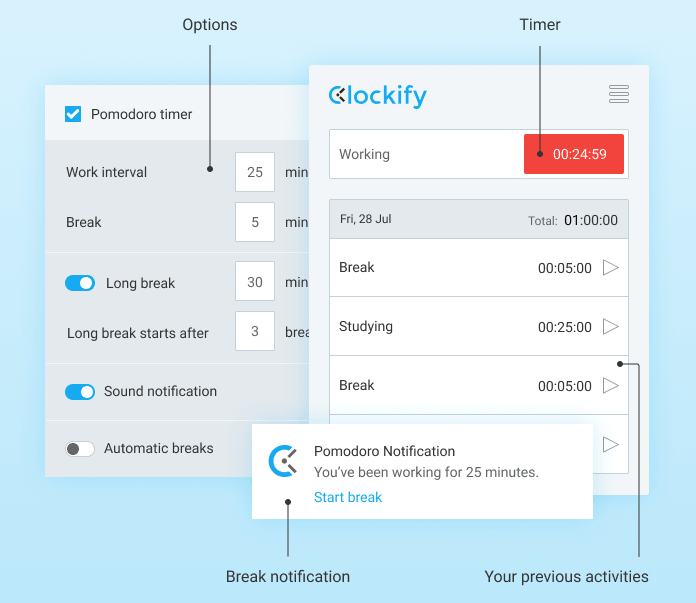
In Clockify, you can choose both the length of your work sessions and the duration of your breaks.
Once you download the right extension, set your custom work interval (e.g. 25 minutes), and your custom break (e.g. 5 minutes), and start the timer for your task.
When your 25-minute work session is done, you’ll be notified that it’s time to take a break.
Likewise, after your 5-minute break is up, you’ll get a notification saying that it’s time to resume work for another 25-minute work session.
You can also decide whether you want to go on a long break — you can define this long break (e.g. 30 minutes), and define when you want it to start (e.g. after 4 breaks).
If you’re a Mac user, you’ll be able to make the most of this technique with the Pomodoro mode in the Clockify time tracker app for Mac. While you track time for tasks, you’ll get a desktop notification once you reach the end of the Pomodoro interval so you can stop the timer for the current task and take a break.
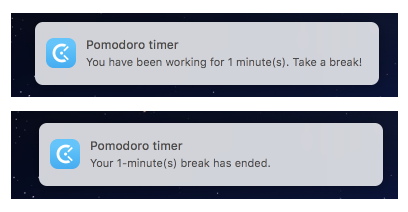
💡 Clockify pro tip
Clockify’s app for Mac has a mode for tracking time using the Pomodoro technique.
Why use Pomodoro
We have already confirmed multitasking is bad for you.
But, giving all your attention to one task only, without pausing to catch your breath, could be as harmful as juggling several projects at the same time.
Apart from helping ward off fatigue, one study has even shown that multiple, meaningful breaks help keep the quality of completed work.
In case you’re still wondering whether the Pomodoro system is right for you, maybe looking at the differences this technique can make to your workflow can help you make up your mind.
| ⏰ Working the Pomodoro way | 🚫 Working without a break |
|---|---|
| ✅ You maintain your energy levels | ❌ You quickly grow tired |
| ✅ You power through any distractions | ❌ You lose your focus |
| ✅ You produce superb quality work | ❌ The quality of your work reduces |
What does science say about Pomodoro?
Although pinpointing the exact levels of productivity for every profession is not a simple task, even for science, several scientific studies have shown the benefits of the Pomodoro technique.
Short breaks keep you focused
Apparently, “brief diversions” are good for our concentration, as a study from the University of Illinois states.
So, when you’re working on a large task for a long period of time, it’s best that you take short breaks — this helps you retain focus once you resume working on said task. That’s how the 5 minute breaks prescribed by the Pomodoro technique actually help the quality of your work.
Breaking tasks down helps you finish them in time
The Pomodoro technique, however, is not only about managing your time, but it’s also helpful in breaking down overwhelming projects to smaller and easier to handle tasks.
Shifting your focus to a goal that is easy to achieve in a 25-minute time span instead of thinking about the faraway future accomplishments helps you finish your tasks even before the deadline.
So, how does breaking down tasks into smaller bits help us complete all assignments in time?
Since we tend to optimistically overestimate the time we’ll have at hand in future, we have a habit of setting unrealistic goals too. However, when you break down any project into smaller chunks, you are able to see the clear picture and estimate the exact time you’ll need to bring it to an end.
Smaller rewards help you stop procrastinating
Breaking a larger project into more manageable tasks can also help you fight the urge to put it off until the last minute just because you have something else on your mind right now.
Although it might seem like you don’t postpone anything without a good reason, science claims everyone procrastinates just because our brains are wired to put things on hold so that we can get the most out of the present moment.
Simply put, because of a phenomenon called present bias we tend to choose to have fun or get a reward right now at the expense of delaying even the most urgent tasks.
Since we cannot easily connect our present self with our future image (the one that’s left to complete the tasks we delay), we feel like we are handing our work over to an entirely different person! This is the moment we choose to binge-watch a TV show simply because the urgent task is not ours to handle anymore.
Yet, as the deadline approaches, anxiety levels increase, and we become aware once again that it is up to us to break this vicious cycle of procrastination.
Pomodoro, however, can put this tiring process to a stop.
By promising yourself a reward that you can easily enjoy during the break time between two pomodoro sessions, you can trick your mind into thinking that fun is just around the corner, and all you have to do is stay focused for a tiny brief moment.
💡 Clockify pro tip
If you want to find out more about how to triumph over present bias, don’t miss out on our article:
Pomodoros go well with your productivity cycle
Another research in favor of the Pomodoro technique at Florida State University indicates that the human body works in cycles of about 90 minutes — everyone has a certain cycle determined in minutes when they are the most productive. Therefore, you are free to choose the length of your Pomodoro cycle — it can be anywhere from 25 to 90 minutes.
But, once 1 cycle is over, in order to maintain your productivity levels, you should take a break and recharge. If you don’t, you’re in danger of suffering from the Ultradian Stress syndrome — which means, when you disrupt your ultradian rhythms, you lose mental focus, make more mistakes, and lower your overall job performance.
Pomodoro Advantages
Maybe the Pomodoro technique sounds too simple. You’re just supposed to start your Pomodoro tracker, sit down, and do your work. After a while, you become a person who’s always able to stick to their schedule, keep their promises and never miss a deadline.
Sounds too good to be true? Maybe you’re still not convinced.
Let’s go over all the benefits this technique offers and see whether it’s truly miraculous as it sounds.
Pomodoro helps you improve your focus
When you determine the exact time you should spend focused on a task, you are actually more likely to truly focus on said task.
In fact, Peter Hollins, the author of The Science of Powerful Focus, claims that the moment you put enough effort and energy into a task at hand, your entire perception of time transforms.
Instead of repeatedly glancing at your watch, impatiently waiting for your workday to end, hours just flash in front of your eyes and you even start to enjoy the process.
When you get into the habit of being entirely devoted to your tasks, you also become able to
differentiate between the time you should spend working and the time you should be on a break. Therefore, you act accordingly.
So, whenever you start a working session, you’ll know this is the time you should focus solely on your work.
However, try not to let anyone distract you. Only after you hear the timer alarm sound you can give in to distractions or just rest for a short while.
💡 Clockify pro tip
If you’re having a hard time avoiding distractions during your focus time, check out our blog post:
After some time practicing Pomodoro, you’ll realize that you have made it your habit to focus during work sessions and unwind during breaks.Instead of continuously working without a schedule you’ll get used to associating the timer you use for the Pomodoro technique with work time.
Pomodoro increases your ability to make estimates
Tracking your time at regular intervals will help you create better estimates.
For example, you parse your daily workload into 25-minute Pomodoros, and start working. This workload may be a small project you have to finish within a day, so you parse the project into tasks and then assign each task to one Pomodoro.
After a while, you may notice that it takes you more than 25 minutes to finish one type of task, and less than 25 minutes to finish another type of task. This revelation will help you parse your tasks better in the future, by maybe assigning two Pomodoros for the first type of tasks and grouping a few smaller tasks into one Pomodoro.
At the end of the day, you’ll know the number of Pomodoros you can finish during your work hours, and you’ll be able to create better time estimates for your clients.
💡Clockify pro tip:
Clockify gives you an option to set an estimate of your project’s duration and budget and to receive an alert when you’re about to go over the budget.
Pomodoro helps eliminate burnout
When you have a lot of work to do within a day, it can be tempting to just work continuously until you’re finished.
But, this is a counterproductive practice that causes a decrease in the quality of your work as time goes by. You continue working with no clear schedule and no breaks, and simply burnout until the end of the day.
Microsoft’s Human Factors Lab has done research to check what actually happens in the human brain when we don’t give ourselves the benefit of a break.
The study shows that uninterrupted work sessions, such as back-to-back meetings, increase our stress levels and lower our ability to focus. Heightened stress levels being one of the primary culprits for burnout, it all becomes clear at this point. The less we rest, the more we stress, and it’s a never-ending struggle.
But, if you parse your time with Pomodoros, you’ll know when you’re allowed to take breaks, which can do wonders for your focus.
Also, knowing how many Pomodoros you can do in a day helps you feel more at ease with your tasks. Instead of feeling like your workday is never going to come to an end, you’ll know that you’ve got only a couple of Pomodoros left and you’re good to go.
💡 Clockify pro tip
Did you know that about 50 percent of people from the United States have experienced burnout?
Burnout is a physical or mental collapse, usually caused by massive stress and overwork. It can arouse symptoms such as anger, irritableness, chest pain, shortness of breath, and dizziness.
To find out more, read our comprehensive post that explains this condition:
Pomodoro lets you track profitability
Apart from using Pomodoro for ensuring your maximum productivity, you can also use it to keep track of your project’s budget and secure your clients’ trust.
Let’s say you finished 8 tasks within 16 Pomodoros and noticed you’ll need to work for 16 more Pomodoros to finish the project. But, you’ve seen that the estimated budget for the time you were going to spend on the project would not be enough to cover expenses and ensure you made enough profit.
As you’ll know it will take 16 more Pomodoros, or about 7 hours, to finish a project, you’ll know to contact the client to revise the budget and increase your hourly rate in the future for that type of project.
💡 Clockify pro tip
Clockify gives you the option to easily set rates, calculate, and track billable hours in real-time. You can even export your billable hours for invoicing with the click of a button.

Pomodoro helps stay on track with productivity levels
The Pomodoro technique gives you a simple way to tell how productive you were, because you can always count the number of Pomodoros you have finished within a day.
Say you’re interested to see what day of the week was most productive for you. You can just count the number of Pomodoros you finished each day, and see when you had the highest score.
Pomodoro gives you time to reset
You may find the Pomodoro breaks to be “unnatural”. After all, you take them when the timer goes off, and that may not necessarily be when you’re feeling tired.
But, these “unnatural” breaks actually help you resume your work faster. When you take a break at fixed intervals, chances are you have left something half-finished, so you’ll have no problem with continuing afterward. The break may even serve you as the time to think about the matters you can tweak and be more creative with when you resume work.
In contrast, when you take a “natural” break, i.e. when the task is most difficult, once you resume your work, chances are you still won’t have a solution to your problem, which will make you feel demoralized and unmotivated.
However, even when you take “unnatural” breaks, you still need to be wary of the way you spend them. If you still feel unmotivated and tired even when you follow the Pomodoro pattern, you could be guilty of wasting your free time.
In case you spend your breaks scrolling through social media, it’s highly likely that you cannot reap the benefits of your free time.
As a behavioural study has shown, reaching for our smartphones during breaks does not leave enough room for our minds to recharge, so we end up being even less ready to tackle our tasks than we were before we took some time off.
Instead of grabbing your phone as soon as the timer goes off, try resting your eyes a bit, stretching, making a cup of coffee or preparing a snack. You will feel more rested and ready to continue where you left off.
Pomodoro Disadvantages
Maybe you’re thrilled with this time management technique and cannot wait for your next work day to begin so that you can start your Pomodoro tracker right on.
However, before you rush into it, it’s only fair to list all the downsides of the Pomodoro technique so that you can try to turn them to your advantage.
Pomodoro timer could disrupt your deep work
The rules state you should stop working on your task as soon as you hear the sound alarm, which can be counterproductive if you’re doing well with your work.
But, you may want to disregard Pomodoro when you’re making progress. If you feel you’re doing especially well with a part of a project, you shouldn’t feel obligated to stop after 25 minutes; you can simply go on until you feel the time is right for a break.
A ready-to-resume intervention can also be quite helpful in case you decide to interrupt your workflow to take a well-deserved break.
Namely, a professor of management at the University of Washington Bothell, Sophie Leroy, claims that whenever our minds wander while we’re engaged in deep work, the best solution is to jot our thoughts down so that we can turn to them later.
This technique could also be useful when you’re about to interrupt your task. Just try to make notes of what was on your mind when the alarm went off, and you’ll be ready to take up right where you left off.
Pomodoro schedule might be too strict
Some people may thrive with the prescribed “25-minute work sessions” and “5 minute breaks”, but others may find that other time intervals work better for them. So, you may want to tweak the rules to fit your needs.
For example, if you’re a programmer, you’ll probably have a number of smaller tasks, tasks that take you about 10 minutes. So, you’ll probably work best if you work in 10-minute Pomodoros.
Or, maybe you find that 25 minutes isn’t enough for you to engross yourself in work. You can set the timer to 45-minute Pomodoros, with longer breaks, say, 15 minutes. After you complete four Pomodoro sessions, you can take a 30-minute break. By tailoring both your Pomodoro sessions and breaks to your work style, you’ll have enough time to work and enough time to unwind.
And maybe you feel stressed over the thought that a timer is counting down the precious seconds of your break time? You may want to choose to set off the timer when on a break and make break time more flexible.
Tips for using Pomodoro
If you are still tortured by second thoughts on how the Pomodoro technique should really look like in practice, we’ve got you covered. We bring you some actionable tips for doing your work the Pomodoro way.
List sessions
List each 25-minute work session on a piece of paper, and then put a check mark next to each item once you are done with it. This way, you’ll always have a sense of progress, so you’ll feel motivated to continue until you’ve reached the end of your list.
In case you’re having trouble adjusting to the new system or you tend to dive right into your tasks as soon as you log in and you forget to start the timer, you can always set an alarm to remind you. If you’re using Clockify Pomodoro timer, you can manually select your focused hours and the timer will remind you when to start tracking your Pomodoros.
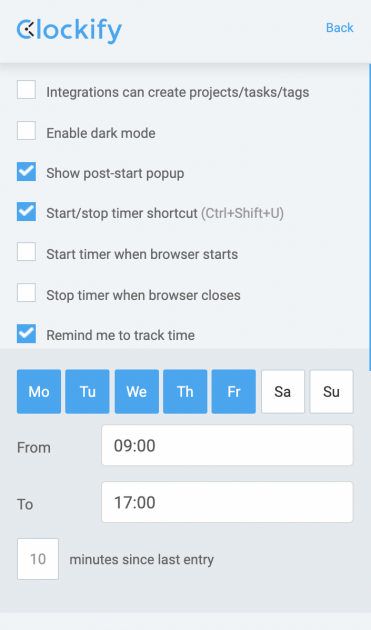
Focus on your work
Once you start the timer, it’s vital that you concentrate on what you’re doing.
This means you should refrain from checking your Facebook feed, reading new posts on your favorite Reddit topic, or staring aimlessly through the window during this period.
Have a rule for dealing with interruptions
Once you have immersed yourself in the 25-minute bubble, don’t let anyone break it. When someone addresses you during this time:
- Inform them that you’re working at the moment.
- Negotiate the time when you’ll be able to address their issue.
- Call back the person in question, when you finish your work.
The Inform/Negotiate/Call back technique will ensure you stay dedicated to your 25-minute routine, without offending the person who wants to engage in conversation.
Change your environment during breaks
Use your 5-minute breaks well. Don’t just sit in your work area until the 5 minutes are up. You can take a bathroom break, refill your glass of water, or make a cup of tea or coffee.
Hopping to your kitchen for a cup of coffee is a good old trick to gain your focus back after spending some time absorbed in a challenging task. Researchers have found that small to moderate amounts of coffee are quite beneficial for both our attention levels and memory.
If you’re not a big fan of coffee, you can stretch yourself, go for a short walk, or engage in another similar activity.
The important detail is that you change your environment, and notify your body you’re on a break; this will help keep your productivity and motivation at optimal levels once you start the timer again.
Use Pomodoro more as a guideline and not as a strict rule
Although you might be excited to try to fit in as many Pomodoros as possible in a day, working more hours does not mean that you are going to be more productive. Even if staying overtime helped you reach your goals once, working long hours puts you at higher risk of burnout in the long run.
Try to avoid burnout by adapting the technique to your own schedule and work style instead of the other way around. If you feel that a 10-minute break would ensure your maximum productivity levels better than a 5-minute one, go for it.
As long as you follow the “work time” — “break time” — “no disruptions” formula, you can tweak your time tracking with the Pomodoro technique the way it works best for you.
Wrapping up
As it is with most productivity techniques, there is no such thing as a magic wand to help you get started. However, the lengthy list of long-term benefits the Pomodoro technique has to offer could maybe be enough to give most of us a nudge in the right direction.
All you need to do is sit down, set your Pomodoro tracker and see if it works for you.
Ready, set, go?
✉️ Have you tried the Pomodoro technique before? Did it help you increase your focus? Let us know at blogfeedback@clockify.me



